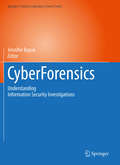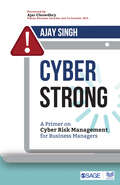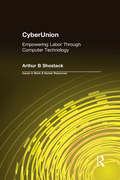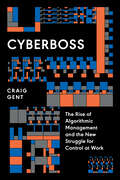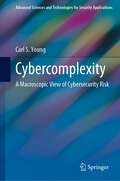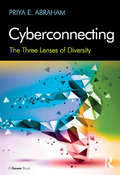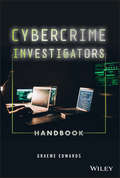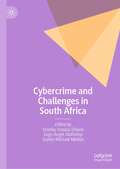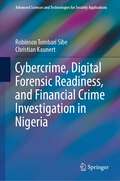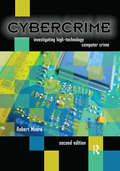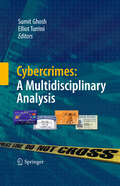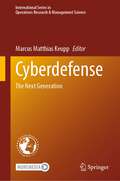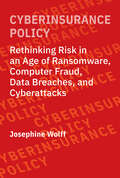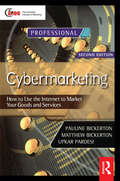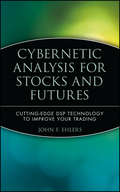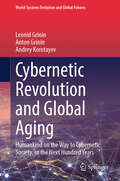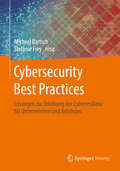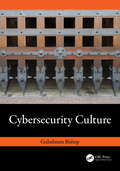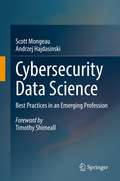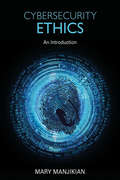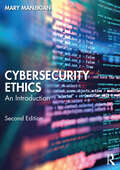- Table View
- List View
CyberForensics: Understanding Information Security Investigations (Springer’s Forensic Laboratory Science Series)
by Jennifer BayukThis fascinating and highly topical subject has a history dating back to the secret world of 1970s Cold War espionage, when the US military and Central intelligence agencies, aided by the latest mainframe systems, were the first to use computer forensics techniques in counterintelligence. In the decades since, cybercrime has emerged from the obscurity of low-level prosecution evidence to become a serious cross-border crime issue, while cyberforensic investigators have moved on from drug, murder, and child pornography crimes that were facilitated by computers, and are now tackling headline-grabbing cyber bank robbery, identity theft, and corporate spying. With little consensus as yet on the qualifications required to become a cyberforensic investigator, Cyberforensics: Understanding Information Security Investigations assembles the varying perspectives of pioneers and key figures in the field. All the authors have more than 10 years' experience in successfully investigating cybercrime, and some more than 20. Through real-life case studies the chapters introduce the reader to the field of cybersecurity, starting with corporate investigation, and progressing to analyze the issues in more detail. Taking us from accounting cyberforensics to unraveling the complexities of malware, the contributors explain the tools and techniques they use in a manner that allows us to map their methodology into a more generic understanding of what a cybersecurity investigation really is. Above all, Cyberforensics shows that there is a cohesive set of concepts that binds cybersecurity investigators to a shared vision. These core ideas are now gaining importance as a body of knowledge that cyberforensics professionals agree should be a prerequisite to the professional practice of information security.
CyberStrong: A Primer on Cyber Risk Management for Business Managers
by Ajay SinghCyber risk is one of the biggest challenges businesses face in the 21st Century. The increasing dependence and use of technology to run businesses combined with the spate of cyber-attacks and risk to reputational damage in recent times has made cybersecurity a top priority for corporates as well as big and small businesses Limited knowledge of cybersecurity among business leaders and managers is a major barrier for effective cyber risk management. This book empowers business managers to assess cyber threats, integrate cybersecurity strategy with business goals, and build appropriate response systems to deal with cyber risks.
CyberUnion: Empowering Labor Through Computer Technology
by Arthur B ShostackKey players in organized labour in the USA and abroad are busy modernizing their communications and making creative and effective use of computers and other technology. The author of this book argues that the road to CyberUnion has begun and that those unions are ensuring a future strength.
Cyberboss: The Rise of Algorithmic Management and the New Struggle for Control at Work
by Craig GentHow technologies of organization are redrawing the lines of class struggleAcross the world, algorithms are changing the nature of work. Nowhere is this clearer than in the logistics and distribution sectors, where workers are instructed, tracked and monitored by increasingly dystopian management technologies.In Cyberboss, Craig Gent takes us into workplaces where algorithms rule to excavate the politics behind the newest form of managerial power. Combining worker testimony and original research on companies such as Amazon, Uber, and Deliveroo, the cutting edge of algorithmic management technology, this book reveals the sometimes unexpected effects these new techniques have on work, workers and managers. Gent advances an alternative politics of resistance in the face of digital control.
Cybercomplexity: A Macroscopic View of Cybersecurity Risk (Advanced Sciences and Technologies for Security Applications)
by Carl S. YoungThis book tackles the problem of complexity within IT environments, i.e., "Cybercomplexity," which is generally recognized as a principal source of cybersecurity risk. The book first defines complexity and simplifies its analysis by assuming a probabilistic approach to security risk management. It then proposes a simple model of cybercomplexity that is based on Shannon entropy, a basic concept in information theory. The key drivers of cybercomplexity emerge from this model, where these drivers reveal the scale-dependence of cybersecurity risk and explain why macroscopic security controls are required to address cybersecurity risk on an enterprise scale. The significant operational implications of cybercomplexity are also discussed, thereby providing both a theoretical framework and a practical guide to addressing this longstanding problem in cybersecurity risk management.
Cyberconnecting: The Three Lenses of Diversity
by Priya E. AbrahamThe ability of organisations to cyberconnect is becoming increasingly important for superior performance. Cyberconnecting: The Three Lenses of Diversity by Dr Priya E. Abraham explains how to establish connections across technological, cultural and social boundaries, mirrored in organisations succeeding in today’s hybrid business world. Some companies create and innovate technology; others use and adopt it; but in the cyberage, both must closely interconnect tech with human behaviour. Face-to-face and cyber-interactions are at the heart of effective work-based relationships, which in turn increase organisational performance. To build these effective business relations, organisations must foster the discovery muscle - curiosity combined with skills - in individuals. Priya E. Abraham shows how seemingly opposing domains (technology, business anthropology and diversity) best leverage interactions for the benefit of organisation development, using findings from practitioner-focused research conducted when leading complex cross-boundary projects in the telecommunications and mobile learning industries. Tools from business anthropology help uncover people’s diverse needs and expectations in a cyberconnected world. Identity portfolios need reflection in development solutions of face-to-face and mobile applications. Solutions uncovered by qualitative research methods help close the gap between human behaviour and tech to engage internal and external stakeholders. The book presents a much-needed strategic framework required for cyberconnecting: 'The Three Lenses of Diversity’, designed to organise thinking in the navigation of technological, cultural, and social boundaries.
Cybercrime Investigators Handbook
by Graeme EdwardsThe investigator’s practical guide for cybercrime evidence identification and collection Cyber attacks perpetrated against businesses, governments, organizations, and individuals have been occurring for decades. Many attacks are discovered only after the data has been exploited or sold on the criminal markets. Cyber attacks damage both the finances and reputations of businesses and cause damage to the ultimate victims of the crime. From the perspective of the criminal, the current state of inconsistent security policies and lax investigative procedures is a profitable and low-risk opportunity for cyber attacks. They can cause immense harm to individuals or businesses online and make large sums of money—safe in the knowledge that the victim will rarely report the matter to the police. For those tasked with probing such crimes in the field, information on investigative methodology is scarce. The Cybercrime Investigators Handbook is an innovative guide that approaches cybercrime investigation from the field-practitioner’s perspective. While there are high-quality manuals for conducting digital examinations on a device or network that has been hacked, the Cybercrime Investigators Handbook is the first guide on how to commence an investigation from the location the offence occurred—the scene of the cybercrime—and collect the evidence necessary to locate and prosecute the offender. This valuable contribution to the field teaches readers to locate, lawfully seize, preserve, examine, interpret, and manage the technical evidence that is vital for effective cybercrime investigation. Fills the need for a field manual for front-line cybercrime investigators Provides practical guidance with clear, easy-to-understand language Approaches cybercrime form the perspective of the field practitioner Helps companies comply with new GDPR guidelines Offers expert advice from a law enforcement professional who specializes in cybercrime investigation and IT security Cybercrime Investigators Handbook is much-needed resource for law enforcement and cybercrime investigators, CFOs, IT auditors, fraud investigators, and other practitioners in related areas.
Cybercrime and Challenges in South Africa
by Sogo Angel Olofinbiyi Stanley Osezua Ehiane Sazelo Michael MkhizeThe advent of the Internet for global advancement and development has opened the world to new crimes. This is the first comprehensive book on the subject matter, considering the absence of textbooks in teaching the subject matter in higher learning institutions. Hitherto, the book is distinctive and timely in the wake of the inclusion of the subject matter as a new curriculum in many African universities. The book focuses on South Africa, where the Internet has been misused by individuals to perpetuated crime which has been on the increase and unabated. The book's contents and its discourse are significant to students in higher institutions, researchers, and organizations, to give in-depth insights into varied cybercrime on various forms and the manners in which cybercrimes have been executed. Lastly, the book contains instances where the Internet has been used to perpetuate crimes in recent times in South Africa.
Cybercrime and Cybersecurity in the Global South: Concepts, Strategies and Frameworks for Greater Resilience
by Corlane Barclay Kweku-Muata Osei-Bryson Charlette DonaldsThe Global South is recognized as one of the fastest growing regions in terms of Internet population as well as the region that accounts for the majority of Internet users. However, It cannot be overlooked that with increasing connectivity to and dependence on Internet-based platforms and services, so too is the potential increased for information and cybersecurity threats and attacks. Further, it has long been established that micro, small, and medium enterprises (MSMEs) play a key role in national economies, serving as important drivers of economic growth in Global South economies. Yet, little is known about information security, cybersecurity and cybercrime issues and strategies contextualized to these developing economies and MSMEs. Cybercrime and Cybersecurity in the Global South: Concepts, Strategies and Frameworks for Greater Resilience examines the prevalence, nature, trends and impacts of cyber-related incidents on Global South economies. It further explores cybersecurity challenges, potential threats, and risks likely faced by MSMEs and governments of the Global South. A major thrust of this book is to offer tools, techniques, and legislative frameworks that can improve the information, data, and cybersecurity posture of Global South governments and MSMEs. It also provides evidence-based best practices and strategies relevant to the business community and general Information Communication Technology (ICT) users in combating and preventing cyber-related incidents. Also examined in this book are case studies and experiences of the Global South economies that can be used to enhance students’ learning experience. Another important feature of this book is that it outlines a research agenda to advance the scholarship of information and cybersecurity in the Global South. Features: Cybercrime in the Caribbean Privacy and security management Cybersecurity compliance behaviour Developing solutions for managing cybersecurity risks Designing an effective cybersecurity programme in the organization for improved resilience The cybersecurity capability maturity model for sustainable security advantage Cyber hygiene practices for MSMEs A cybercrime classification ontology
Cybercrime, Digital Forensic Readiness, and Financial Crime Investigation in Nigeria (Advanced Sciences and Technologies for Security Applications)
by Christian Kaunert Robinson Tombari SibeNigeria has become one of the hotbeds of cybercrime since the liberalization of the telecommunication industry began in 1996. The scale and magnitude have been quite disturbing, not just for Nigeria but also for the international community, given the limitless boundaries of cybercrime. Like any other type of fraud, Internet fraud is primarily driven by financial gains. This book investigates the extent of the lack of digital forensic resources in Nigeria’s financial crime agencies. It is vital to have a proper resource inventory and capabilities to successfully confront the growing threat of financial crimes. While a few studies have suggested the lack of forensic capabilities in Nigerian cybercrime investigative agencies and the justice system, none have examined this in great detail, particularly in relation to specific skills gaps and resources needed in Nigeria’s financial crime agencies. This book contributes to the growing body of knowledge and clarifies the scope of the lack of digital forensic resources. Understanding the extent of the deficiency and its impact on caseloads could be crucial for developing a roadmap toward building forensic readiness and capability maturity for the agencies. This book presents the deficiencies in forensic readiness and recommends measures to fill this gap. This book also examines the specifics of the cybercrime caseloads and conviction records in Nigeria, identifying trends and patterns. The book explores other cybercrime complexities in Nigeria, such as common cybercrime taxonomies, prosecution, and conviction dynamics, juxtaposing it with select case studies in other jurisdictions. Drawing on extensive research, the book offers crucial insights for policymakers, researchers, and the public interested in new trends in cybercrime, digital forensic readiness, Nigerian financial crime agencies, and cybercrime investigations.
Cybercrime: Investigating High-Technology Computer Crime
by Robert MooreThis innovative text provides an excellent introduction to technology-assisted crime and the basics of investigating such crime, from the criminal justice perspective. It presents clear, concise explanations for students and professionals, who need not be technically proficient to find the material easy-to-understand and practical. The book begins by identifying and defining the most prevalent and emerging high-technology crimes -- and exploring their history, their original methods of commission, and their current methods of commission. Then it delineates the requisite procedural issues associated with investigating technology-assisted crime. In addition, the text provides a basic introduction to computer forensics, explores legal issues in the admission of digital evidence, and then examines the future of high-technology crime, including legal responses.
Cybercrimes: A Multidisciplinary Analysis
by Sumit Ghosh Elliot TurriniDesigned to serve as a reference work for practitioners, academics, and scholars worldwide, this book is the first of its kind to explain complex cybercrimes from the perspectives of multiple disciplines (computer science, law, economics, psychology, etc.) and scientifically analyze their impact on individuals, society, and nations holistically and comprehensively. In particular, the book shows: How multiple disciplines concurrently bring out the complex, subtle, and elusive nature of cybercrimes How cybercrimes will affect every human endeavor, at the level of individuals, societies, and nations How to legislate proactive cyberlaws, building on a fundamental grasp of computers and networking, and stop reacting to every new cyberattack How conventional laws and traditional thinking fall short in protecting us from cybercrimes How we may be able to transform the destructive potential of cybercrimes into amazing innovations in cyberspace that can lead to explosive technological growth and prosperity
Cyberdefense: The Next Generation (International Series in Operations Research & Management Science #342)
by Marcus Matthias KeuppThis book analyzes cyberdefense from a novel and interdisciplinary perspective, offering solutions for problems that have long impeded a more efficient defense. It explains why cyberdefense organized and performed by humans is too slow, too cumbersome, and too ineffective. Combining the analytical capabilities of experts in operations research and management, international security studies, economics, risk analysis, and defense management, the volume addresses these problems of current cyberdefense. The authors present suggestions for the next generation of cyberdefense, explaining why the future defense must focus on speeding up responses, why a single response may not be enough, and why effectiveness requires foresight.This makes the book a must-read for scholars, researchers, intelligence analysts, homeland security staff, and professionals who are interested in learning more about the issues of current cyberdefense, as well as solutions for the next generation of cyberdefense.
Cyberinsurance Policy: Rethinking Risk in an Age of Ransomware, Computer Fraud, Data Breaches, and Cyberattacks (Information Policy)
by Josephine WolffWhy cyberinsurance has not improved cybersecurity and what governments can do to make it a more effective tool for cyber risk management.As cybersecurity incidents—ranging from data breaches and denial-of-service attacks to computer fraud and ransomware—become more common, a cyberinsurance industry has emerged to provide coverage for any resulting liability, business interruption, extortion payments, regulatory fines, or repairs. In this book, Josephine Wolff offers the first comprehensive history of cyberinsurance, from the early &“Internet Security Liability&” policies in the late 1990s to the expansive coverage offered today. Drawing on legal records, government reports, cyberinsurance policies, and interviews with regulators and insurers, Wolff finds that cyberinsurance has not improved cybersecurity or reduced cyber risks. Wolff examines the development of cyberinsurance, comparing it to other insurance sectors, including car and flood insurance; explores legal disputes between insurers and policyholders about whether cyber-related losses were covered under policies designed for liability, crime, or property and casualty losses; and traces the trend toward standalone cyberinsurance policies and government efforts to regulate and promote the industry. Cyberinsurance, she argues, is ineffective at curbing cybersecurity losses because it normalizes the payment of online ransoms, whereas the goal of cybersecurity is the opposite—to disincentivize such payments to make ransomware less profitable. An industry built on modeling risk has found itself confronted by new technologies before the risks posed by those technologies can be fully understood.
Cybermarketing: How To Use The Superhighway To Market Your Products And Services (Cim Practitioner Ser.)
by Pauline Bickerton Matthew Bickerton Upkar Pardesi'Cybermarketing' is a no-nonsense structured guide to using the Internet for marketing and is essential reading for all marketers and managers who need to know how to use the Internet to promote and sell their product. This new edition both follows on the success of and adds significantly to the first edition by:* Increasing the up to date case material* Having a live Internet site to support the book * Adding a collection of key URLs for market research purposes* Adding a new section on marketing information systems* More coverage on electronic direct and 1 to 1 marketing* Covering intranets for Marcomms in more depth* Building on 'Justifying the Business Case'* Updated and expanded information on pricing and branding.This new edition, confirms 'Cybermarketing' as both the most comprehensive and accessible guide to the net for marketing professionals at all levels.
Cybernetic Analysis for Stocks and Futures
by John F. EhlersCutting-edge insight from the leader in trading technology In Cybernetic Analysis for Stocks and Futures, noted technical analyst John Ehlers continues to enlighten readers on the art of predicting the market based on tested systems. With application of his engineering expertise, Ehlers explains the latest, most advanced techniques that help traders predict stock and futures markets with surgical precision. Unique new indicators and automatic trading systems are described in text as well as Easy Language and EFS code. The approaches are universal and robust enough to be applied to a full range of market conditions. John F. Ehlers (Santa Barbara, CA) is President of MESA Software (www. mesasoftware. com) and has also written Rocket Science for Traders (0-471-40567-1) as well as numerous articles for Futures and Technical Analysis of Stocks & Commodities magazines.
Cybernetic Approach to Project Management
by Bogdan LentThis book attempts to reflect the project reality as closely as possible, covering the ISO 21500:2012 standard that has just been introduced and the benefits from the best contributions worldwide and also providing the concise yet powerful tool box. It shall be easy to use and intuitively supportive of project managers. So far, evidence indicates that these targets are successfully met. One of its key recognitions, and in consequence a distinctive feature of this book, is the impact that the project manager's personality has on the fate of the project. The project manager's successful self-management in work & life and in leadership processes should be considered as important in any endeavor as all other project management processes, covered by the new standards and guidelines.
Cybernetic Revolution and Global Aging: Humankind on the Way to Cybernetic Society, or the Next Hundred Years (World-Systems Evolution and Global Futures)
by Leonid Grinin Andrey Korotayev Anton GrininThis book explores the global technological transformations that have shaped development of society for eons, from the emergence of Homo sapiens to the modern day. Looking at a potential future for all of this century and the beginning of the next, the book explores how society is changing as a result of the two most powerful trends: technological advances and global aging. It studies the forthcoming technological wave – the Cybernetic Revolution, which will encompass AI, medical technology and biotechnology, robotics, cognitive, nanotechnology etc. In turn, it shows why and how global aging will become one of the most powerful factors, influencing the evolution of society and the World System as a whole. Lastly, the book demonstrates how technological innovations can change the way people live and the society of the future, assessing both the new opportunities and threats posed by uncontrolled technological progress. Accordingly, it will appeal to social scientists, political scientists, economists and historians who are interested in technological transformations and their social and economic impacts.
Cybernetics and Systems: Social and Business Decisions (Routledge-Giappichelli Systems Management)
by Raul Espejo Sergio Barile Igor Perko Marialuisa SavianoSociety is now facing challenges for which the traditional management toolbox is increasingly inadequate. Well-grounded theoretical frameworks, such as systems thinking and cybernetics, offer general level interpretation schemes and models that are capable of supporting understanding of complex phenomena and are not impacted by the passage of time. This book serves the knowledge society to address the complexity of decision making and problem solving in the 21st century with contributions from systems and cybernetics. A multi-disciplinary approach has been adopted to support diversity and to develop inter- and trans-disciplinary knowledge within the shared thematic of problem solving and decision making in the 21st century. Its conceptual thread is cyber/systemic thinking, and its realisation is supported by a wide network of scientists on the basis of a highly participative agenda. The book provides a platform of knowledge sharing and conceptual frameworks developed with multi-disciplinary perspectives, which are useful to better understand the fast changing scenario and the complexity of problem solving in the present time.
Cybersecurity Best Practices: Lösungen zur Erhöhung der Cyberresilienz für Unternehmen und Behörden
by Michael Bartsch Stefanie FreyDas Thema Cybersecurity ist so aktuell wie nie, denn im Cyberspace lassen sich nur schwer Grenzen in Bezug auf den Zugang zu Informationen, Daten und Redefreiheit setzen. Kriminelle nutzen die Lücken oft zu ihrem Vorteil aus. Die Vielzahl der IT-Systeme, ihre unterschiedlichen Nutzungsarten und ihre Innovations- und Lebenszyklen haben zu hohen Sicherheitsrisiken für Unternehmen und staatliche Einrichtungen geführt. Diese Risiken werden sich auch langfristig nicht so einfach aus der Welt schaffen lassen. Daher müssen Institutionen Strategien und Lösungen zu ihrem Selbstschutz entwickeln. Dieses Buch beschreibt Lösungsansätze und Best Practices aus den unterschiedlichsten Bereichen, die nachweislich zu einer höheren Resilienz gegenüber Cyberangriffen führen. Weltweit renommierte IT-Sicherheitsexperten berichten in 40 Beiträgen, wie sich staatliche Institutionen, unter anderem das Militär (Cyber Defence), Behörden, internationale Organisationen und Unternehmen besser gegen Cyberangriffe schützen und nachhaltige Schutzstrategien entwickeln können. Die Autoren widmen sich den Gründen und Zielen, die ihren jeweiligen Strategien zugrunde liegen, sie berichten, wie Unternehmen auf konkrete Cyberattacken reagiert haben und wie einzelne staatliche Institutionen angesichts nationaler Cyberstrategien agieren. In weiteren Kapiteln zeigen Wissenschaftler auf, was bei der Abwehr von Cyber-Attacken bereits heute möglich ist, welche Entwicklungen in Arbeit sind und wie diese in Zukunft eingesetzt werden können, um die Cyber-Sicherheit zu erhöhen. Im letzten Kapitel berichten Hersteller, Anwenderunternehmen und Dienstleister welche Best Practices sie in ihren Unternehmen eingeführt haben und wie andere Unternehmen ihrem Beispiel folgen können. Das Buch richtet sich an IT-Verantwortliche und -Sicherheitsbeauftragte in Unternehmen und anderen Organisationen, aber auch an Studierende in den verschiedenen IT-Studiengängen.
Cybersecurity Culture
by Gulsebnem BishopThe culture of cybersecurity is a complex subject. We can look at cybersecurity culture from different perspectives. We can look at it from the organizational point of view or from within the culture. Each organization has a culture. Attitudes toward security have different manifestations in each organizational culture. We also see how the cybersecurity phenomenon unfolds in other cultures is complicated. Each culture reacts differently to this phenomenon. This book will emphasize both aspects of cybersecurity. From the organizational point of view, this book will emphasize the importance of the culture of cybersecurity in organizations, what it is, and how it can be achieved. This includes the human aspects of security, approach and awareness, and how we can design systems that promote the culture of security. It is also important to emphasize the psychological aspects briefly because it is a big part of the human approach.From a cultural point of view, this book will emphasize how different cultures approach the culture of cybersecurity. The cultural complexity of cybersecurity will be noted by giving examples from different cultures. How leadership in different cultures approach security and how different cultures approach change. Case studies from each culture will be presented to demonstrate different approaches to implementing security and training practices. Overall, the textbook will be a good resource for cybersecurity students who want to understand how cultures and organizations within those cultures approach security. It will also provide a good resource for instructors who would like to develop courses on cybersecurity culture.Finally, this book will be an introductory resource for anyone interested in cybersecurity's organizational or cultural aspects.
Cybersecurity Data Science: Best Practices in an Emerging Profession
by Scott Mongeau Andrzej HajdasinskiThis book encompasses a systematic exploration of Cybersecurity Data Science (CSDS) as an emerging profession, focusing on current versus idealized practice. This book also analyzes challenges facing the emerging CSDS profession, diagnoses key gaps, and prescribes treatments to facilitate advancement. Grounded in the management of information systems (MIS) discipline, insights derive from literature analysis and interviews with 50 global CSDS practitioners. CSDS as a diagnostic process grounded in the scientific method is emphasized throughout Cybersecurity Data Science (CSDS) is a rapidly evolving discipline which applies data science methods to cybersecurity challenges. CSDS reflects the rising interest in applying data-focused statistical, analytical, and machine learning-driven methods to address growing security gaps. This book offers a systematic assessment of the developing domain. Advocacy is provided to strengthen professional rigor and best practices in the emerging CSDS profession. This book will be of interest to a range of professionals associated with cybersecurity and data science, spanning practitioner, commercial, public sector, and academic domains. Best practices framed will be of interest to CSDS practitioners, security professionals, risk management stewards, and institutional stakeholders. Organizational and industry perspectives will be of interest to cybersecurity analysts, managers, planners, strategists, and regulators. Research professionals and academics are presented with a systematic analysis of the CSDS field, including an overview of the state of the art, a structured evaluation of key challenges, recommended best practices, and an extensive bibliography.
Cybersecurity Ethics: An Introduction
by Mary ManjikianThis new textbook offers an accessible introduction to the topic of cybersecurity ethics. The book is split into three parts. Part I provides an introduction to the field of ethics, philosophy and philosophy of science, three ethical frameworks – virtue ethics, utilitarian ethics and communitarian ethics – and the notion of ethical hacking. Part II applies these frameworks to particular issues within the field of cybersecurity, including privacy rights, intellectual property and piracy, surveillance, and cyberethics in relation to military affairs. The third part concludes by exploring current codes of ethics used in cybersecurity. The overall aims of the book are to: provide ethical frameworks to aid decision making; present the key ethical issues in relation to computer security; highlight the connection between values and beliefs and the professional code of ethics. The textbook also includes three different features to aid students: ‘Going Deeper’ provides background information on key individuals and concepts; ‘Critical Issues’ features contemporary case studies; and ‘Applications’ examine specific technologies or practices which raise ethical issues. The book will be of much interest to students of cybersecurity, cyberethics, hacking, surveillance studies, ethics and information science.
Cybersecurity Ethics: An Introduction
by Mary ManjikianThis textbook offers an accessible introduction to the topic of cybersecurity ethics. The second edition has been revised and updated, and contains new chapters on social justice, AI, and Big Data. The book is split into three parts. Part I provides an introduction to the field of ethics, philosophy, and philosophy of science, three ethical frameworks – virtue ethics, utilitarian ethics, and communitarian ethics – and the notion of ethical hacking. Part II applies these frameworks to particular issues within the field of cybersecurity, including privacy rights, surveillance, and intellectual property. The third part concludes by exploring current codes of ethics used in cybersecurity, with chapters on artificial intelligence, social diversity, Big Data, and cyberwarfare. The overall aims of the book are to: Provide ethical frameworks to aid decision-making Present the key ethical issues in relation to computer security Highlight the connection between values and beliefs and the professional code of ethics The textbook also includes three different features to aid students: "Going Deeper" features provide background on individuals, events, and institutions in cybersecurity; "Critical Issues" features contemporary case studies; and "Tech Talks" contain features that assume some familiarity with technological developments. The book will be of much interest to students of cybersecurity, cyberethics, hacking, surveillance studies, ethics, and information science.
